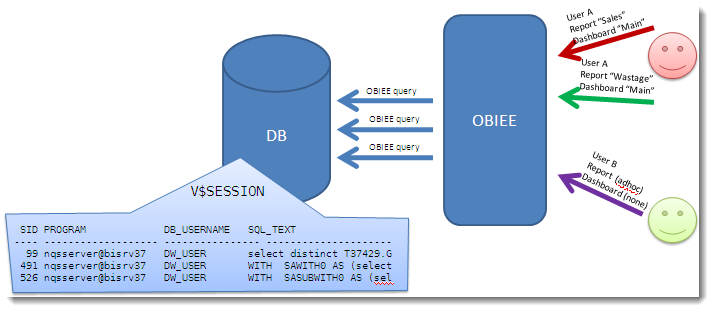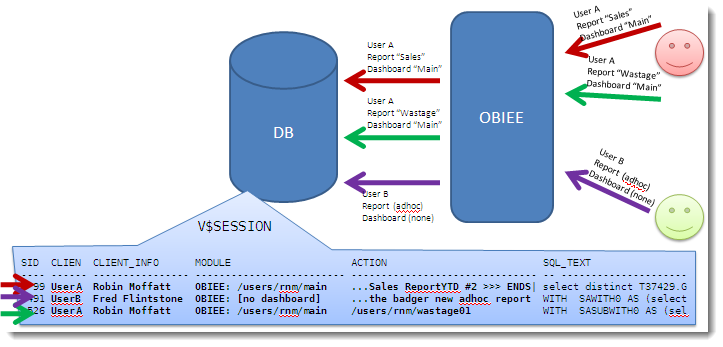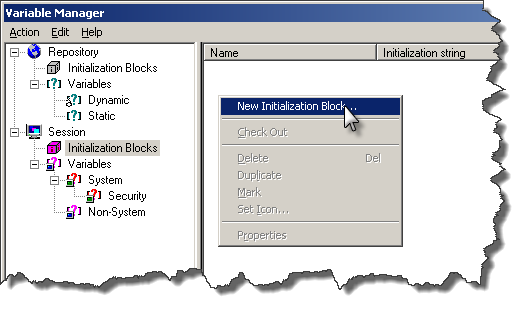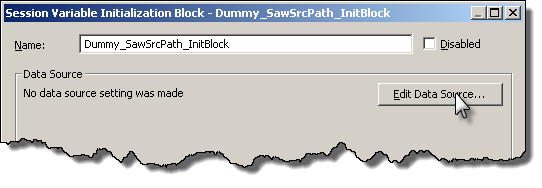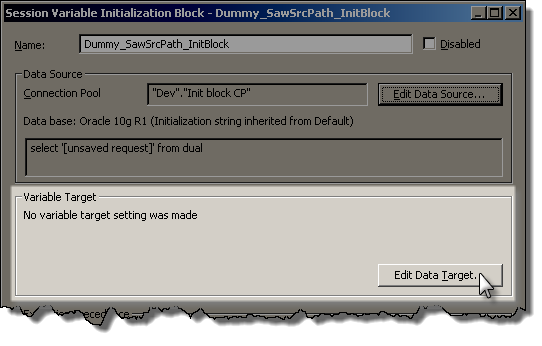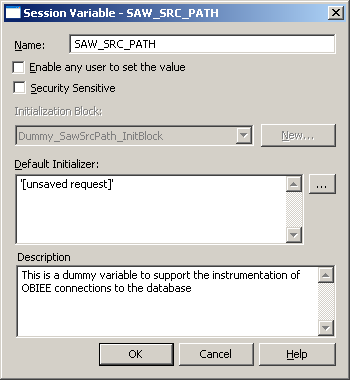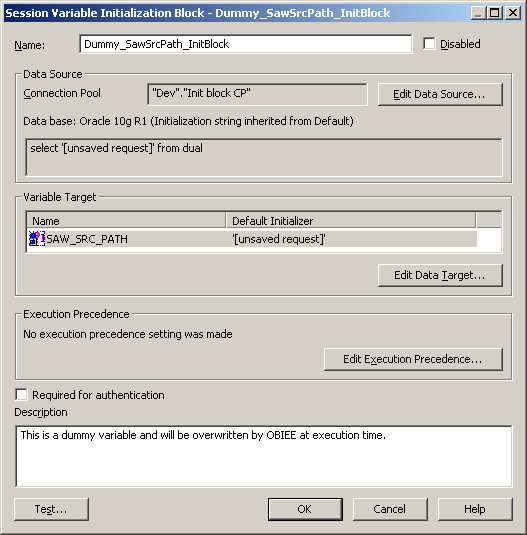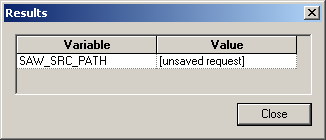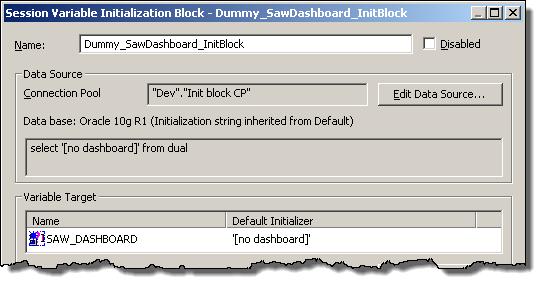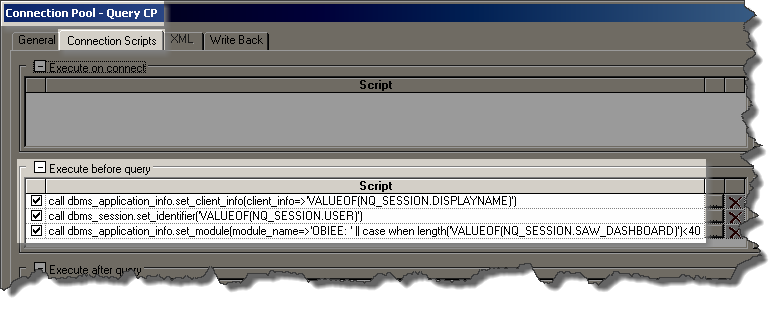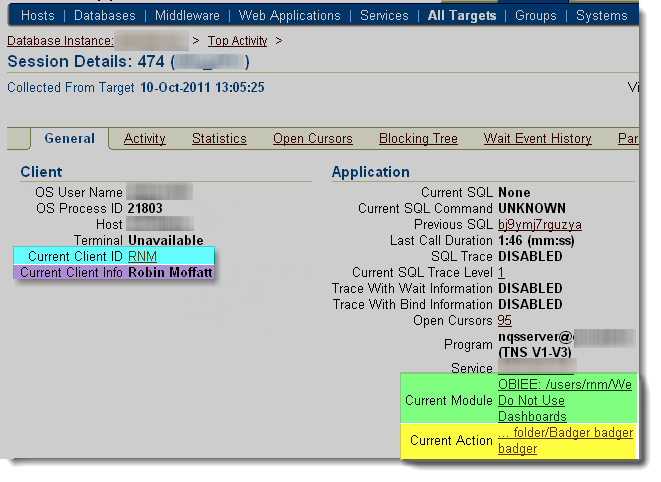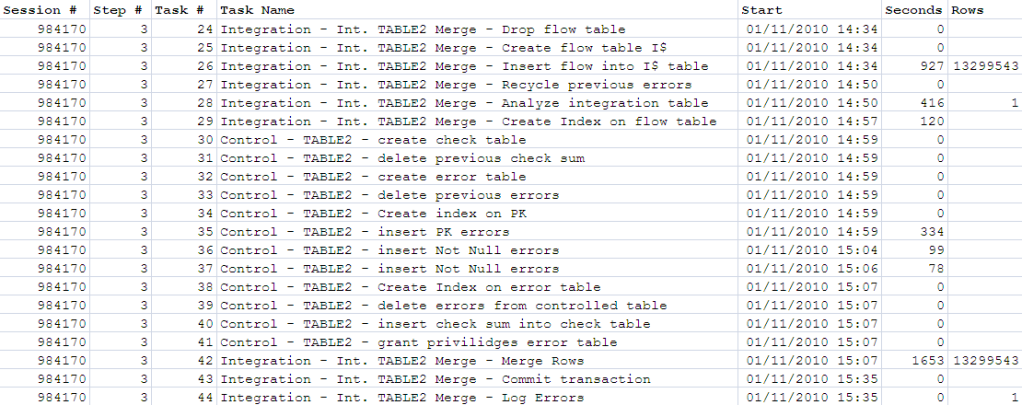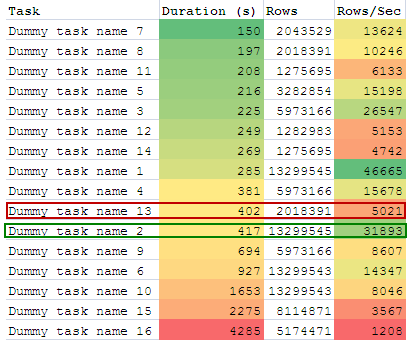Introduction
We’re in the process of implemention Resource Manager (RM) on our Oracle 11gR1 Data Warehouse. We’ve currently got one DW application live, but have several more imminent. We identified RM as a suitable way of – as the name would suggest – managing the resources on the server.
In the first instance we’re looking at simply protecting CPU for, and from, future applications. At some point it would be interesting to use some of the more granular and precise functions to demote long-running queries, have nighttime/daytime plans, etc.
I’d also like to explore the management of IO but for us the pain is in bandwidth that a query consumes, and it looks like RM can only work with total session MB, or IOPS. Reading about Exadata it sounds like the Exadata I/O Resource Management might do this ([…]It allows intra and inter-database I/O bandwidth to be defined and managed[..]). But for that I’ll have to write to Santa and promise to be a good boy this year.
Here are some good resources for learning about Resource Manager:
Our implementation of RM
Our initial aim with RM is to do nothing more than ensure that everything we need to run does not do so at the expense of other applications on the server. A 64-way parallel beast of a query should not be allowed to freeze out lightweight workload from application backend processes (such as Usage Tracking, Informatica and DAC Repositories, etc).
We’ve implemented this by grouping schema IDs from the four projects into consumer groups (PROJ_A_GRP, PROJ_B_GRP, PROJ_C_GRP, PROJ_D_GRP). The other group where users are explicitly defined is SYS_GROUP, for the SYS and SYSTEM users. All other users (i.e. those from application backend processes) go in the OTHER_GROUP.
Our Resource Plan is this: CPU priority is allocated entirely to SYSTEM_GROUP. If any is remaining, it is allocated to OTHER_GROUP. Any CPU remaining after that gets divided up in quarters to the four project groups. It’s worth pointing out that Oracle itself manages Oracle core processes, in a group called _ORACLE_BACKGROUND_GROUP_.
Here’s the contents of V$RSRC_PLAN, DBA_RSRC_PLANS, and DBA_RSRC_PLAN_DIRECTIVES for the current active plan:
ID NAME IS_TOP_PLAN CPU_MANAGED
---------- -------------------------------- ----------- -----------
1020578 DW_PLAN TRUE ON
NUM_PLAN SUB
PLAN_ID PLAN DIRECTIVES CPU_METHOD MGMT_METHOD ACTIVE_SESS_POOL_MTH PARALLEL_DEGREE_LIMIT_MTH QUEUEING_MTH PLAN
--------- ---------- ---------- ---------------- ---------------- -------------------------------- -------------------------------- ---------------- ------
1020578 DW_PLAN 6 EMPHASIS EMPHASIS ACTIVE_SESS_POOL_ABSOLUTE PARALLEL_DEGREE_LIMIT_ABSOLUTE FIFO_TIMEOUT NO
PLAN GROUP_OR_SUBPLAN TYPE CPU_P1 CPU_P2 CPU_P3 MGMT_P1 MGMT_P2 MGMT_P3
---------- -------------------- -------------- ------ ------ ------ ------- ------- -------
DW_PLAN SYS_GROUP CONSUMER_GROUP 100 0 0 100 0 0
DW_PLAN OTHER_GROUPS CONSUMER_GROUP 0 100 0 0 100 0
DW_PLAN PROJ_A_GRP CONSUMER_GROUP 0 0 25 0 0 25
DW_PLAN PROJ_B_GRP CONSUMER_GROUP 0 0 25 0 0 25
DW_PLAN PROJ_C_GRP CONSUMER_GROUP 0 0 25 0 0 25
DW_PLAN PROJ_D_GRP CONSUMER_GROUP 0 0 25 0 0 25
My understanding of RM’s control of CPU is that in essence it does nothing, until the database is under CPU pressures. Once queries are being constrained by CPU, RM will enforce the allocation of CPU between the various consumer groups as defined in the currently active Resource Plan.
Note that RM is only within the Oracle context – it cannot do anything about non-Oracle processes on the same server using lots of CPU. An example of this that we’ve seen is ODI agents running local to the database – if these are doing lots of work then they may impact Oracle but we cannot use RM to control it.
Here’s my understanding of how we’ll see RM in action – and as you’ll see from the tests that I run, I’m not sure that it is entirely correct. Generally, there will be no SYSTEM_GROUP activity, and very minimal OTHER_GROUP activity. This leaves the lion’s share for our application queries/ETL. Until the CPU on the box hits 100%, no throttling will be done. This is important to note. Our allocation of 25% CPU to PROJ_A_GRP only means that it is the minimum it can expect (see below – this doesn’t seem to be correct). If nothing else is running, it will get 100%. Conversely, if an application backend process (in the OTHER_GROUP consumer group) is using lots of CPU, let’s say 60%, and all four project groups are demanding CPU, then each will get 25% of the remaining 40% of the box’s capacity, i.e. 10% host CPU.
Scripts to Monitor and Test RM
It’s important to know that RM is doing what we think it is, and to also be able to determine the current state of a system in terms of resources. If a system is at 100% CPU and users are demanding why RM “isn’t working” it will be useful to prove that it is non-Oracle processes creating the CPU demand.
I’ve been working on some queries to both validate and monitor RM. This excellent whitepaper on RM has some queries illustrating how to use v$rsrcmgrmetric_history to report on RM behaviour. I built on this to incorporate V$SYSMETRIC_HISTORY to source host CPU %, creating this query which infers the workload on the system.
We’re looking at system statistics per minute slice (which is the level that v$rsrcmgrmetric_history is at, and then GROUP_ID=2 on V$SYSMETRIC_HISTORY).
The source metrics are :
- CPU count – From v$osstat where stat_name = 'NUM_CPUS'.
- Host CPU utilisation (%) – From V$SYSMETRIC_HISTORY where metric_id = 2057. This number should match the CPU usage as reported by the host (e.g. through sar, top, glance etc)
- Used Oracle Seconds – From V$RSRCMGRMETRIC_HISTORY.cpu_consumed_time. The number of CPU seconds that Oracle thinks it has consumed
From this are derived:
- Total Available CPU Seconds – The number of CPU seconds per minute slice available is going to be 60 seconds multiplied by the number of CPUs that in theory could be running Oracle work. Obviously in practice Oracle can’t use 100% of this CPU time, but this number’s a useful starting point for the following derivations
- Total Used Seconds – Total CPU time, divided by the host CPU utilisation. So if the CPU is at 50% utilisation and there are 480 CPU seconds available per minute, then logically 240 CPU seconds must have been used over that minute. Note that this is the total number of CPU seconds used, both Oracle and Non-Oracle.
- Non-Oracle Seconds Used – Total CPU time, divided by the host CPU utilisation, minus the number of CPU seconds Oracle has used.
From the above derived figures percentages are calculated too.
rm_cpu_01.sql:
/* System CPU and Resource Manager impact over time
Based on : http://www.oracle.com/technetwork/database/features/performance/resource-manager-twp-133705.pdf
and http://download.oracle.com/docs/cd/B28359_01/server.111/b28320/dynviews_3084.htm#I1030344
https://rnm1978.wordpress.com/
*/
set linesize 160
set pagesize 50
set colsep ' ' -- thanks @Boneist 🙂
column "Total Available CPU Seconds" head "Total Available|CPU Seconds" format 990
column "Used Oracle Seconds" head "Used Oracle|Seconds" format 990.9
column "Used Host CPU %" head "Used Host|CPU %" format 990.9
column "Idle Host CPU %" head "Idle Host|CPU %" format 990.9
column "Total Used Seconds" head "Total Used|Seconds" format 990.9
column "Idle Seconds" head "Idle|Seconds" format 990.9
column "Non-Oracle Seconds Used" head "Non-Oracle|Seconds Used" format 990.9
column "Oracle CPU %" head "Oracle|CPU %" format 990.9
column "Non-Oracle CPU %" head "Non-Oracle|CPU %" format 990.9
column "throttled" head "Oracle Throttled|Time (s)" format 990.9
select to_char(rm.BEGIN_TIME,'YYYY-MM-DD HH24:MI:SS') as BEGIN_TIME
,60 * (select value from v$osstat where stat_name = 'NUM_CPUS') as "Total Available CPU Seconds"
,sum(rm.cpu_consumed_time) / 1000 as "Used Oracle Seconds"
,min(s.value) as "Used Host CPU %"
,(60 * (select value from v$osstat where stat_name = 'NUM_CPUS')) * (min(s.value) / 100) as "Total Used Seconds"
,((100 - min(s.value)) / 100) * (60 * (select value from v$osstat where stat_name = 'NUM_CPUS')) as "Idle Seconds"
,((60 * (select value from v$osstat where stat_name = 'NUM_CPUS')) * (min(s.value) / 100)) - sum(rm.cpu_consumed_time) / 1000 as "Non-Oracle Seconds
Used"
,100 - min(s.value) as "Idle Host CPU %"
,((((60 * (select value from v$osstat where stat_name = 'NUM_CPUS')) * (min(s.value) / 100)) - sum(rm.cpu_consumed_time) / 1000) / (60 * (select valu
e from v$osstat where stat_name = 'NUM_CPUS')))*100 as "Non-Oracle CPU %"
,(((sum(rm.cpu_consumed_time) / 1000) / (60 * (select value from v$osstat where stat_name = 'NUM_CPUS'))) * 100) as "Oracle CPU %"
, sum(rm.cpu_wait_time) / 1000 as throttled
from gv$rsrcmgrmetric_history rm
inner join
gV$SYSMETRIC_HISTORY s
on rm.begin_time = s.begin_time
where s.metric_id = 2057
and s.group_id = 2
group by rm.begin_time,s.begin_time
order by rm.begin_time
/
This is my server when Oracle is at rest:
Total Available Used Oracle Used Host Total Used Idle Non-Oracle Idle Host Non-Oracle Oracle Oracle Throttled
BEGIN_TIME CPU Seconds Seconds CPU % Seconds Seconds Seconds Used CPU % CPU % CPU % Time (s)
------------------- --------------- ----------- --------- ---------- ------- ------------ --------- ---------- ------ ----------------
2010-09-10 14:45:51 480 3.0 1.8 8.4 471.6 5.4 98.2 1.1 0.6 0.0
2010-09-10 14:46:50 480 3.0 1.7 8.0 472.0 5.0 98.3 1.0 0.6 0.0
2010-09-10 14:47:50 480 3.4 3.9 18.6 461.4 15.2 96.1 3.2 0.7 0.0
2010-09-10 14:48:50 480 0.7 2.1 10.1 469.9 9.4 97.9 2.0 0.1 0.0
2010-09-10 14:49:50 480 0.3 1.3 6.3 473.7 6.0 98.7 1.2 0.1 0.0
2010-09-10 14:50:51 480 0.2 2.2 10.8 469.2 10.6 97.8 2.2 0.0 0.0
N.B. at high CPU usage I’ve seen errors appear in the derived numbers, with negative values for non-oracle time and percentage. I’d speculate that this is because we’re dealing with percentage (CPU) figures averaged out over a minute, but cumulative figures (used Oracle seconds) over the same period.
The CPU figure is validated by output from sar (give or take a percentage point):
HP-UX myserver B.11.31 U ia64 09/10/10
14:45:47 %usr %sys %wio %idle
14:46:47 1 1 0 98
14:47:47 1 1 0 98
14:48:47 3 1 0 96
14:49:47 1 1 0 98
14:50:47 1 1 0 98
CPU usage by consumer group can be examined in more detail using this script, rm_05.sql:
/* CPU usage and RM impact over time, by consumer group, per minute
Derived from : http://www.oracle.com/technetwork/database/features/performance/resource-manager-twp-133705.pdf
https://rnm1978.wordpress.com
*/
set linesize 160
set pagesize 60
set colsep ' '
column total head "Total Available|CPU Seconds" format 990
column consumed head "Used|Oracle Seconds" format 990.9
column consumer_group_name head "Consumer|Group Name" format a25 wrap off
column "throttled" head "Oracle Throttled|Time (s)" format 990.9
column cpu_utilization head "% of Host CPU" format 990.9
break on time skip 2 page
select to_char(begin_time, 'YYYY-DD-MM HH24:MI:SS') time,
consumer_group_name,
60 * (select value from v$osstat where stat_name = 'NUM_CPUS') as total,
cpu_consumed_time / 1000 as consumed,
cpu_consumed_time / (select value from v$parameter where name = 'cpu_count') / 600 as cpu_utilization,
cpu_wait_time / 1000 as throttled
from v$rsrcmgrmetric_history
order by begin_time,consumer_group_name
/
Total Available Used Oracle Throttled
TIME CONSUMER_GROUP_NAME CPU Seconds Oracle Seconds % of Host CPU Time (s)
------------------- ------------------------------ --------------- -------------- ------------------ ----------------
2010-10-09 14:37:50 PROJ_C_GRP 480 40.4 8.4 0.0
PROJ_A_GRP 480 0.0 0.0 0.0
PROJ_B_GRP 480 0.0 0.0 0.0
OTHER_GROUPS 480 5.0 1.0 0.0
PROJ_D_GRP 480 0.0 0.0 0.0
SYS_GROUP 480 0.0 0.0 0.0
_ORACLE_BACKGROUND_GROUP_ 480 0.0 0.0 0.0
For details of each session within a consumer group I use script rm_02.sql:
/*
Resource Manager / Session details
V$RSRC_SESSION_INFO
http://download.oracle.com/docs/cd/B28359_01/server.111/b28320/dynviews_2153.htm#REFRN30404
https://rnm1978.wordpress.com
*/
SET pagesize 50
SET linesize 155
SET wrap off
COLUMN name format a11 head "Consumer|Group"
COLUMN sid format 9999
COLUMN username format a16
COLUMN CONSUMED_CPU_TIME head "Consumed|CPU time|(s)" format 999999.9
COLUMN IO_SERVICE_TIME head "I/O time|(s)" format 9999.9
COLUMN CPU_WAIT_TIME head "CPU Wait|Time (s)" FOR 99999
COLUMN CPU_WAITS head "CPU|Waits" format 99999
COLUMN YIELDS head "Yields" format 99999
COLUMN state format a10
COLUMN osuser format a8
COLUMN machine format a16
COLUMN PROGRAM format a12
SELECT
rcg.name
, rsi.sid
, s.username
, rsi.state
, rsi.YIELDS
, rsi.CPU_WAIT_TIME / 1000 AS CPU_WAIT_TIME
, rsi.CPU_WAITS
, rsi.CONSUMED_CPU_TIME / 1000 AS CONSUMED_CPU_TIME
, rsi.IO_SERVICE_TIME /1000 AS IO_SERVICE_TIME
, s.osuser
, s.program
, s.machine
, sw.event
FROM V$RSRC_SESSION_INFO rsi INNER JOIN v$rsrc_consumer_group rcg
ON rsi.CURRENT_CONSUMER_GROUP_ID = rcg.id
INNER JOIN v$session s ON rsi.sid=s.sid
INNER JOIN v$session_wait sw ON s.sid = sw.sid
WHERE rcg.id !=0 -- _ORACLE_BACKGROUND_GROUP_
and (sw.event != 'SQL*Net message from client' or rsi.state='RUNNING')
ORDER BY rcg.name, s.username,rsi.cpu_wait_time + rsi.IO_SERVICE_TIME + rsi.CONSUMED_CPU_TIME ASC, rsi.state, sw.event, s.username, rcg.name,s.machine,s.osuser
/
N.B. When quoting the output from this query I cut sessions such as the one running the query itself, and other non-relevant processes (eg non-active monitoring etc):
Consumed
Consumer CPU Wait CPU CPU time I/O time
Group SID USERNAME STATE Yields Time (s) Waits (s) (s) OSUSER PROGRAM MACHINE EVENT
----------- ----- ---------------- ---------- ------ -------- ------ --------- -------- -------- ------------ ---------------- ----------------------------
PROJ_A_GRP 1089 PROJA_USR RUNNING 53 3 53 426.0 .0 myuser0 sqlplus@aser aserver resmgr:cpu quantum
PROJ_B_GRP 523 PROJB_USR RUNNING 284 17 284 412.4 .0 myuser0 sqlplus@aser aserver latch free
PROJ_B_GRP 508 PROJB_USR RUNNING 272 18 272 410.7 .0 myuser0 sqlplus@aser aserver latch free
PROJ_B_GRP 1090 PROJB_USR RUNNING 52 3 52 426.0 .0 myuser0 sqlplus@aser aserver latch free
To generate load on the database I’ve got a script, hit_cpu.sql, that is based on one provided by one of our DBAs:
/* Generate CPU load
Based on http://jhdba.wordpress.com/2009/11/19/maxing-out-cpus-script/
https://rnm1978.wordpress.com
*/
set timing on
select to_char(sysdate,'YYYY-MM-DD HH24:MI:SS') as start_time from dual
/
declare a number := 1;
begin for i in 1..1000000000
loop a := ( a + i )/11;
end loop;
end;
/
select to_char(sysdate,'YYYY-MM-DD HH24:MI:SS') as end_time from dual;
/
Test 01
I started the hit_cpu script at 15:38:32. You can see its impact :
Total Available Used Oracle Used Host Oracle Throttled
BEGIN_TIME CPU Seconds Seconds CPU % Time (s)
------------------- --------------- ----------- --------- ----------------
2010-09-10 15:37:50 480 17.8 5.7 0.0
2010-09-10 15:38:50 480 58.5 14.3 0.0
2010-09-10 15:39:50 480 59.5 14.3 0.0
2010-09-10 15:40:50 480 60.3 15.3 0.0
2010-09-10 15:41:50 480 58.3 15.4 0.0
2010-09-10 15:42:50 480 59.3 14.7 0.0
2010-09-10 15:43:50 480 58.4 13.9 0.0
2010-09-10 15:44:50 480 59.3 14.3 0.0
2010-09-10 15:45:50 480 58.6 13.8 0.0
2010-09-10 15:46:50 480 58.4 14.0 0.0
2010-09-10 15:47:50 480 31.8 10.0 0.0
2010-09-10 15:48:50 480 0.1 1.3 0.0
(for the purposes of this article the derived measures are a distraction, and possibly inaccurate too, so I’ve omitted them from here on)
Very satisfyingly, for each 60-second slice Oracle is using just under 60 seconds of CPU – i.e. my script is loading one CPU.
Total Available Used Oracle Throttled
TIME CONSUMER_GROUP_NAME CPU Seconds Oracle Seconds % of Host CPU Time (s)
------------------- ------------------------------ --------------- -------------- ------------------ ----------------
2010-10-09 15:38:50 PROJ_C_GRP 480 0.0 0.0 0.0
PROJ_A_GRP 480 0.0 0.0 0.0
PROJ_B_GRP 480 0.0 0.0 0.0
OTHER_GROUPS 480 58.5 12.2 0.0
PROJ_D_GRP 480 0.0 0.0 0.0
SYS_GROUP 480 0.0 0.0 0.0
_ORACLE_BACKGROUND_GROUP_ 480 0.0 0.0 0.0
sar matches up with the CPU figures from Oracle:
%usr %sys %wio %idle
15:38:47 4 1 0 95
15:39:47 14 1 0 85
15:40:47 14 1 0 85
15:41:47 14 1 0 84
15:42:47 15 1 0 84
15:43:47 14 1 0 85
15:44:47 14 1 0 86
15:45:47 14 1 0 85
15:46:47 14 1 0 86
15:47:47 14 1 0 86
15:48:47 10 1 0 89
15:49:47 1 1 0 98
Test 02
I added two more scripts into the test, initiating them from a shell script using the ampersand operator to create them as background jobs running in parallel:
/app/oracle/product/11.1.0/db_1/bin/sqlplus USER/PW @hit_cpu &
/app/oracle/product/11.1.0/db_1/bin/sqlplus USER/PW @hit_cpu &
/app/oracle/product/11.1.0/db_1/bin/sqlplus USER/PW @hit_cpu &
(The sqlplus path is specified because I’ve got an alias for ‘sqlplus’ to use ied, and it doesn’t like running concurrently from the same shell)
The scripts started at 2010-09-10 15:57:54. Monitoring showed three CPUs being utilised (“Used Oracle Seconds” – c.178 seconds = 3 x c.60 seconds) by Oracle:
Total Available Used Oracle Used Host
BEGIN_TIME CPU Seconds Seconds CPU %
------------------- --------------- ----------- ---------
2010-09-10 15:56:50 480 0.8 1.6
2010-09-10 15:57:50 480 156.9 3.5
2010-09-10 15:58:50 480 175.1 1.8
2010-09-10 15:59:50 480 190.9 11.1
2010-09-10 16:00:50 480 177.8 4.2
2010-09-10 16:01:51 480 174.9 2.8
2010-09-10 16:02:50 480 175.3 3.8
2010-09-10 16:03:50 480 185.8 5.9
2010-09-10 16:04:50 480 174.9 2.4
2010-09-10 16:05:50 480 175.2 6.8
2010-09-10 16:06:50 480 174.1 2.4
2010-09-10 16:07:50 480 4.9 2.2
However notice the “Used Host CPU %” value – a very low value, and not matching with sar for the same period:
%usr %sys %wio %idle
15:57:47 1 1 0 97
15:58:47 33 1 0 65
15:59:47 39 1 0 60
16:00:47 45 1 0 54
16:01:47 40 1 0 59
16:02:47 40 1 0 60
16:03:47 40 1 0 59
16:04:47 41 1 0 57
16:05:47 39 1 0 60
16:06:47 41 2 0 57
16:07:47 39 1 0 60
16:08:47 4 1 0 95
I can’t explain (explanations welcome!) why V$SYSMETRIC_HISTORY is [apparently] incorrect for this period.
I re-ran the test and Host CPU was picked up correctly by Oracle. The results on the second run matched the first:
Total Available Used Oracle Used Host
BEGIN_TIME CPU Seconds Seconds CPU %
------------------- --------------- ----------- ---------
2010-09-10 21:52:50 480 0.1 1.6
2010-09-10 21:53:50 480 0.2 1.3
2010-09-10 21:54:50 480 140.2 32.6
2010-09-10 21:55:50 480 177.9 41.1
2010-09-10 21:56:50 480 174.9 42.1
2010-09-10 21:57:50 480 177.6 40.4
2010-09-10 21:58:50 480 174.8 39.6
2010-09-10 21:59:50 480 189.0 43.0
2010-09-10 22:00:50 480 177.7 40.0
2010-09-10 22:01:50 480 174.5 42.2
2010-09-10 22:02:50 480 178.0 40.8
2010-09-10 22:03:51 480 180.8 41.3
2010-09-10 22:04:50 480 12.3 4.0
2010-09-10 22:05:50 480 0.1 1.7
2010-09-10 22:06:50 480 0.2 1.8
Test 03
The next test I ran used the hit_cpu script and was called once from a user in one each of the four consumer groups, plus a user not allocated a consumer group and therefore in OTHER_GROUP. Five scripts in total, so should expect to see CPU usage around (5 x c.60) = c.300 seconds, and machine CPU at something like (5/8)*100 so c.60-70%
Test started at 2010-09-10 16:20:20. CPU immediately hit about 64% – which based on my calculation above was satisfying 🙂
Using rm_05 (see above), the breakdown of Oracle CPU time could be seen:
Total Available Used Oracle Throttled
TIME CONSUMER_GROUP_NAME CPU Seconds Oracle Seconds % of Host CPU Time (s)
------------------- ------------------------------ --------------- -------------- ------------------ ----------------
2010-10-09 16:20:50 PROJ_C_GRP 480 58.2 12.1 0.0
PROJ_A_GRP 480 58.2 12.1 0.0
PROJ_B_GRP 480 58.2 12.1 0.0
OTHER_GROUPS 480 58.8 12.3 0.0
PROJ_D_GRP 480 58.4 12.2 0.0
SYS_GROUP 480 0.0 0.0 0.0
_ORACLE_BACKGROUND_GROUP_ 480 0.0 0.0 0.0
rm_cpu_01 showed Oracle using c.290 CPU seconds per minute (again inline with estimate – yeah!), and this time the Host CPU % looked accurate:
Total Available Used Oracle Used Host Oracle Throttled
BEGIN_TIME CPU Seconds Seconds CPU % Time (s)
------------------- --------------- ----------- --------- ----------------
2010-09-10 16:20:50 480 291.9 66.1 0.0
2010-09-10 16:21:50 480 291.5 65.0 0.0
sar matched up :
%usr %sys %wio %idle
16:21:47 65 2 0 34
16:22:47 64 1 0 35
(note that sar’s timestamp is the END of a sample, whereas the BEGIN_TIME in my Oracle queries is the BEGINNING of a sample)
Test 04
Having seen that RM is correctly assigning our different users to the appropriate consumer groups, we can start testing how RM behaves once the host CPU hits capacity and RM has to start throttling its allocation to the groups.
In theory eight instances of the script should be enough to load the CPU entirely (since there are eight CPUs on the server). I ran four as a user from PROJ_B_GRP and four from PROJ_A_GRP, starting at 2010-09-10 18:27:53
As predicated CPU usage hits about 100%, according to sar:
%usr %sys %wio %idle
18:27:38 2 1 0 97
18:28:38 69 2 0 29
18:29:38 92 1 0 7
18:30:38 99 1 0 0
18:31:38 96 1 0 3
18:32:38 99 1 0 0
18:33:38 96 1 0 3
and this is reflected by Oracle too (rm_cpu_01):
Total Available Used Oracle Used Host Oracle Throttled
BEGIN_TIME CPU Seconds Seconds CPU % Time (s)
------------------- --------------- ----------- --------- ----------------
2010-09-10 18:26:50 480 1.0 2.3 0.0
2010-09-10 18:27:51 480 444.2 89.5 8.8
2010-09-10 18:28:50 480 472.9 95.0 0.0
2010-09-10 18:29:50 480 465.5 99.1 5.5
2010-09-10 18:30:50 480 462.1 97.0 32.2
2010-09-10 18:31:49 480 473.6 100.0 0.1
2010-09-10 18:32:50 480 458.5 95.2 24.7
We can see that of the 480 CPU seconds available in every minute slice, Oracle is using almost all of it – around 470 seconds.
Looking at Resource Manager, we can see that it kicks in – in the time slice beginning at 18:30:50, Oracle constrained one or some of the queries by a total of 30 seconds. Using rm_02 we can see how this divides up among the sessions. “CPU Wait Time (s)” corresponds to the “Oracle Throttled Time (s)” in rm_cpu_01 and rm_05(bearing in mind different levels of granularity since one is per minute / consumer group and one is per session total).
Consumer CPU Wait CPU CPU time I/O time
Group SID USERNAME STATE Yields Time (s) Waits (s) (s) OSUSER PROGRAM MACHINE EVENT
----------- ----- ---------------- ---------- ------ -------- ------ --------- -------- -------- ------------ ---------------- ----------------------------
PROJ_A_GRP 1094 PROJA_USR RUNNING 61 2 61 960.5 .0 myuser0 sqlplus@aser aserver resmgr:cpu quantum
PROJ_A_GRP 553 PROJA_USR RUNNING 302 16 302 946.8 .0 myuser0 sqlplus@aser aserver latch free
PROJ_A_GRP 498 PROJA_USR RUNNING 310 19 310 945.2 .0 myuser0 sqlplus@aser aserver latch free
PROJ_A_GRP 1089 PROJA_USR RUNNING 61 3 61 960.5 .0 myuser0 sqlplus@aser aserver resmgr:cpu quantum
PROJ_B_GRP 1078 PROJB_USR RUNNING 56 4 56 959.5 .0 myuser0 sqlplus@aser aserver latch free
PROJ_B_GRP 523 PROJB_USR RUNNING 301 17 301 946.7 .0 myuser0 sqlplus@aser aserver latch free
PROJ_B_GRP 508 PROJB_USR RUNNING 290 19 290 945.1 .0 myuser0 sqlplus@aser aserver latch free
PROJ_B_GRP 1090 PROJB_USR RUNNING 61 3 61 960.4 .0 myuser0 sqlplus@aser aserver latch free
and aggregated to consumer group level (script rm_05):
Total Available Used Oracle Throttled
TIME CONSUMER_GROUP_NAME CPU Seconds Oracle Seconds % of Host CPU Time (s)
------------------- ------------------------------ --------------- -------------- ------------------ ----------------
2010-10-09 18:30:50 PROJ_C_GRP 480 0.0 0.0 0.0
PROJ_A_GRP 480 217.7 45.4 13.1
PROJ_B_GRP 480 215.8 45.0 15.0
OTHER_GROUPS 480 28.6 6.0 4.1
PROJ_D_GRP 480 0.0 0.0 0.0
SYS_GROUP 480 0.0 0.0 0.0
_ORACLE_BACKGROUND_GROUP_ 480 0.0 0.0 0.0
Note that the throttling is applied pretty much equally to both consumer groups. In plan terms, CPU for level 1 (100% to SYS_GROUP) is unused, so passes to level 2 (100% to OTHER_GROUP). OTHER_GROUP consumes a small amount, and note that it is not [really] throttled. The remaining CPU (96%, from rm_cpu_01, minus 6% shown in rm_05 output = c.90%), is passed onto level 3 of the plan. Whilst the four projects are defined an allocation of 25% each in the plan, two of the consumer groups are not consuming their chunk, so it is divided up amongst the groups that are, according to the ratio of their allocations. Hence, PROJ_A_GRP and PROJ_B_GRP are using c.45% of host CPU.
N.B. see below for discussion around allocation of CPU, as this statement about ratio may not be true.
Test 05
Test 04 above showed that RM applies throttling evenly to consumer groups, but it could have been influenced by an equal number of sessions for each consumer group running (that is, if it had throttled in a round-robin manner the result could have been the same).
This test will run a similar workload, but with a skewed number of sessions; 1 PROJ_A_GRP and 7 PROJ_B_GRP.
The test began at 2010-09-10 19:03:22.
Total CPU usage is about 84%, which on an eight-CPU box is c.1 CPU unused. Script rm_cpu_01 shows:
Total Available Used Oracle Used Host Oracle Throttled
BEGIN_TIME CPU Seconds Seconds CPU % Time (s)
------------------- --------------- ----------- --------- ----------------
2010-09-10 19:00:51 480 0.2 3.9 0.0
2010-09-10 19:01:50 480 0.2 1.4 0.0
2010-09-10 19:02:51 480 182.9 41.7 37.8
2010-09-10 19:03:50 480 398.5 85.0 83.0
2010-09-10 19:04:51 480 383.1 83.2 82.4
2010-09-10 19:05:50 480 388.7 83.4 83.7
2010-09-10 19:06:51 480 388.0 84.8 80.8
2010-09-10 19:07:51 480 386.8 84.7 81.0
2010-09-10 19:08:50 480 383.4 83.1 83.4
2010-09-10 19:09:50 480 388.4 83.7 79.2
2010-09-10 19:10:50 480 383.0 83.4 85.4
2010-09-10 19:11:50 480 390.6 83.5 85.4
2010-09-10 19:12:51 480 378.7 85.3 83.1
2010-09-10 19:13:50 480 392.5 83.4 81.1
2010-09-10 19:14:51 480 384.9 82.9 82.9
2010-09-10 19:15:50 480 373.0 81.1 79.8
2010-09-10 19:16:50 480 303.3 67.1 66.2
2010-09-10 19:17:50 480 293.9 65.8 59.2
2010-09-10 19:18:50 480 293.7 66.7 59.0
2010-09-10 19:19:50 480 242.4 55.0 58.3
2010-09-10 19:20:50 480 237.2 53.8 59.3
2010-09-10 19:21:51 480 233.1 53.0 58.4
2010-09-10 19:22:50 480 219.7 50.5 48.8
2010-09-10 19:23:50 480 0.8 1.6 0.0
This breaks down according to rm_05 into:
Total Available Used Oracle Throttled
TIME CONSUMER_GROUP_NAME CPU Seconds Oracle Seconds % of Host CPU Time (s)
------------------- ------------------------------ --------------- -------------- ------------- ----------------
2010-10-09 19:13:50 PROJ_C_GRP 480 0.0 0.0 0.0
PROJ_A_GRP 480 59.2 12.3 0.0
PROJ_B_GRP 480 333.2 69.4 81.1
OTHER_GROUPS 480 0.1 0.0 0.0
PROJ_D_GRP 480 0.0 0.0 0.0
SYS_GROUP 480 0.0 0.0 0.0
_ORACLE_BACKGROUND_GROUP_ 480 0.0 0.0 0.0
(all the minute time slices have same approximate CPU / seconds values)
rm_02 shows the individual sessions:
Consumed
Consumer CPU Wait CPU CPU time I/O time
Group SID USERNAME STATE Yields Time (s) Waits (s) (s) PROGRAM EVENT
----------- ----- ---------------- ---------- ------ -------- ------ --------- -------- ------------ --------------------------------------------
PROJ_A_GRP 521 PROJA_USR RUNNING 2 0 2 766.9 .0 sqlplus@aser resmgr:cpu quantum
PROJ_B_GRP 1084 PROJB_USR RUNNING 5385 225 5385 574.0 .0 sqlplus@aser resmgr:cpu quantum
PROJ_B_GRP 1082 PROJB_USR RUNNING 5416 228 5416 571.1 .0 sqlplus@aser resmgr:cpu quantum
PROJ_B_GRP 1098 PROJB_USR WAITING FO 5373 224 5373 575.3 .0 sqlplus@aser resmgr:cpu quantum
PROJ_B_GRP 1070 PROJB_USR RUNNING 5405 224 5405 575.0 .0 sqlplus@aser resmgr:cpu quantum
PROJ_B_GRP 1075 PROJB_USR RUNNING 5424 222 5424 577.3 .0 sqlplus@aser resmgr:cpu quantum
PROJ_B_GRP 498 PROJB_USR RUNNING 0 0 0 799.7 .0 sqlplus@aser latch free
PROJ_B_GRP 508 PROJB_USR RUNNING 1 0 1 799.7 .0 sqlplus@aser resmgr:internal state change
OTHER_GROUP 491 myuser0 RUNNING 0 0 1 .4 .0 sqlplus@aser SQL*Net message to client
So – PROJ_A_GRP is getting all the CPU that it needs (since it is shown as having zero CPU Wait Time (rm_02) and zero throttled time (rm_05). The session is also shown (in rm_05) as consuming almost 60 CPU seconds in a 60 second time slice.
The PROJ_B_GRP has two sessions that apparently run unconstrained, and five that are throttled by RM. The output from rm_cpu_01 above shows that RM throttles the queries by roughly 80 seconds of CPU time per minute. Over five sessions (and rm_02 above shows the constraining being applied equally) that equates to c.16 seconds of CPU time per session.
Even once the first queries complete c.19:17 and the CPU usage drops further, RM still appears to throttle the PROJ_B_GRP queries.
So here is my first major puzzlement with RM:
- I would have expected to see all seven PROJ_B_GRP sessions constrained at the same rate.
- Why were the PROJ_B_GRP queries throttled even when there was idle CPU? From 19:17 onwards there was around 35% idle.
FWIW the scripts were started from a shell script similar to above, with the PROJ_B_GRP sessions first, and then PROJ_A_GRP session.
Test 06
In Test 05 PROJ_A_GRP was running only one process, so would not be demanding as much or more than its theoretical 25% allocation. This test will run three PROJ_A_GRP sessions and which would (based on Test 02 above) require c.36% host CPU to run. In addition I will run six PROJ_B_GRP sessions, theoretical CPU requirement of c.72% host CPU. The total CPU should be driven above 100% and RM kick in.
My understanding (which could be wrong) of RM is that it will do as it did above when there were equal numbers of sessions in each consumer group to throttle; it will allocate the resource 50:50 to the two consumer groups, even though the ratio of sessions will be 1:2.
The test started at 2010-09-10 19:43:51. The results were different from what I had expected.
CPU didn’t hit 100%, staying around 85%. Overall it looked like this (rm_cpu_01):
Total Available Used Oracle Used Host Oracle Throttled
BEGIN_TIME CPU Seconds Seconds CPU % Time (s)
------------------- --------------- ----------- --------- ----------------
2010-09-10 19:40:50 480 0.4 0.9 0.0
2010-09-10 19:41:50 480 0.2 1.1 0.0
2010-09-10 19:42:50 480 2.5 3.8 0.1
2010-09-10 19:43:51 480 424.7 85.5 101.6
2010-09-10 19:44:50 480 420.0 84.4 101.3
2010-09-10 19:45:50 480 422.6 84.1 105.7
2010-09-10 19:46:50 480 423.4 84.0 106.7
2010-09-10 19:47:50 480 425.3 83.2 107.4
sar reports pretty much the same cpu (the figure of 68% here is because of the time at which the test started versus the point in the minute at which sar is recording from):
%usr %sys %wio %idle
19:41:38 1 1 0 99
19:42:38 1 1 0 98
19:43:38 1 1 0 98
19:44:38 68 1 0 31
19:45:38 85 1 0 14
19:46:38 84 1 0 15
19:47:38 83 1 0 17
19:48:38 83 1 0 16
RM throttled both consumer groups – but by a different amount to what I had expected. Taking a minute slice (and all were almost the same) using rm_05:
Total Available Used Oracle Throttled
TIME CONSUMER_GROUP_NAME CPU Seconds Oracle Seconds % of Host CPU Time (s)
------------------- ------------------------------ --------------- -------------- ------------- ----------------
2010-10-09 19:44:50 PROJ_C_GRP 480 0.0 0.0 0.0
PROJ_A_GRP 480 135.2 28.2 38.4
PROJ_B_GRP 480 284.7 59.3 62.8
OTHER_GROUPS 480 0.1 0.0 0.2
PROJ_D_GRP 480 0.0 0.0 0.0
SYS_GROUP 480 0.0 0.0 0.0
_ORACLE_BACKGROUND_GROUP_ 480 0.0 0.0 0.0
So RM appears to guarenteeing PROJ_A_GRP at least 25% CPU (per the resource plan), but after than it allocates twice as much CPU to PROJ_B_GRP
Individual sessions (rm_02):
Consumed
Consumer CPU Wait CPU CPU time I/O time
Group SID USERNAME STATE Yields Time (s) Waits (s) (s) PROGRAM EVENT
----------- ----- ---------------- ---------- ------ -------- ------ --------- -------- ------------ --------------------------------------------
PROJ_A_GRP 508 PROJA_USR RUNNING 1600 128 1600 255.5 .0 sqlplus@aser resmgr:cpu quantum
PROJ_A_GRP 553 PROJA_USR RUNNING 1599 122 1599 262.2 .0 sqlplus@aser resmgr:cpu quantum
PROJ_A_GRP 1098 PROJA_USR RUNNING 8 0 8 384.1 .0 sqlplus@aser resmgr:cpu quantum
PROJ_B_GRP 1070 PROJB_USR RUNNING 4 0 4 383.4 .0 sqlplus@aser latch free
PROJ_B_GRP 523 PROJB_USR WAITING FO 1844 146 1844 237.8 .0 sqlplus@aser resmgr:cpu quantum
PROJ_B_GRP 1084 PROJB_USR RUNNING 2 0 2 384.2 .0 sqlplus@aser resmgr:cpu quantum
PROJ_B_GRP 496 PROJB_USR RUNNING 1843 148 1843 236.2 .0 sqlplus@aser resmgr:cpu quantum
PROJ_B_GRP 1075 PROJB_USR RUNNING 0 0 0 384.4 .0 sqlplus@aser latch free
PROJ_B_GRP 489 PROJB_USR RUNNING 1836 146 1836 238.7 .0 sqlplus@aser resmgr:cpu quantum
So here is my next puzzlement with RM:
- Is it possible that CPU isn’t hitting 100% because RM is throttling the queries too much?
I suspect I’m misunderstanding something about how RM is supposed to work and/or how it is implemented to do what it does.
Test 07
Leaving to one side my inability to explain the above observations with RM, I then wantd to add more load so that the machine would be under serious CPU pressure, and see how RM dealt with it.
I would run:
- 2 x OTHER_GROUP sessions
- 5 x PROJ_A_GRP sessions
- 1 x PROJ_B_GRP session
- 10 x PROJ_C_GRP sessions
- 1 x PROJ_D_GRP session
I would hope to see something like this:
- OTHER_GROUP unthrottled – c.20% CPU, leaving c.80% for the four project consumer groups (thus 20% each)
- PROJ_B_GRP unthrottled – only generating load on one CPU so c.12% host CPU (leaving c.8% available for use by other consumer groups)
- PROJ_D_GRP unthrottled – only generating load on one CPU so c.12% host CPU (leaving c.8% available for use by other consumer groups)
- This leaves 56% (100 – 20 – 12 – 12) of a theoretical 100% CPU available for two consumer groups which between them require more than that. Based on the above results I would expect the 1:2 session balance to play out in CPU allocation too, so roughly:
- PROJ_C_GRP throttled to c.<40%
- PROJ_A_GRP throttled to c.<20%
The test began at 2010-09-10 20:21:49, taking a total of three seconds for all 17 scripts to start.
As before, CPU did not hit 100%, but instead hovered around 87%. We’re quite clearly generating load sufficient to hit 100%, but RM is throttling it back. Whether it’s the effect of swapping queries on and off CPU that means there’s an efficiency loss, or whether RM deliberately holds it back to that level deliberately I don’t know.
The total Oracle and host CPU/time looks like this: (rm_cpu_01):
Total Available Used Oracle Used Host Oracle Throttled
BEGIN_TIME CPU Seconds Seconds CPU % Time (s)
------------------- --------------- ----------- --------- ----------------
2010-09-10 20:18:50 480 0.1 1.1 0.0
2010-09-10 20:19:50 480 0.1 3.1 0.0
2010-09-10 20:20:50 480 14.5 5.8 9.5
2010-09-10 20:21:51 480 421.4 88.1 675.4
2010-09-10 20:22:50 480 431.9 88.6 690.4
2010-09-10 20:23:50 480 433.6 88.7 685.5
2010-09-10 20:24:50 480 427.0 89.3 686.1
2010-09-10 20:25:50 480 424.2 89.5 683.1
The CPU allocation within RM breaks down as follows (rm_05):
Total Available Used Oracle Throttled
TIME CONSUMER_GROUP_NAME CPU Seconds Oracle Seconds % of Host CPU Time (s)
------------------- ------------------------------ --------------- -------------- ------------- ----------------
2010-10-09 20:22:50 PROJ_C_GRP 480 138.8 28.9 451.9
PROJ_A_GRP 480 115.0 24.0 179.7
PROJ_B_GRP 480 27.9 5.8 31.1
OTHER_GROUPS 480 115.7 24.1 3.4
PROJ_D_GRP 480 34.5 7.2 24.4
SYS_GROUP 480 0.0 0.0 0.0
_ORACLE_BACKGROUND_GROUP_ 480 0.0 0.0 0.0
- OTHER_GROUP gets c.25%, and isn’t throttled
- PROJ_C_GRP gets c.25%, and is throttled
- PROJ_A_GRP gets c.25%, and is throttled
- PROJ_B_GRP gets c.6%, and is throttled
- PROJ_D_GRP gets c.6%, and is throttled
(I’m taking a slight liberty with OTHER_GROUP and stating that it’s not throttled; but relative to the other groups it isn’t really)
rm_02 shows the amount of CPU wait time each session is subject to:
Consumed
Consumer CPU Wait CPU CPU time I/O time
Group SID USERNAME STATE Yields Time (s) Waits (s) (s) PROGRAM EVENT
----------- ----- ---------------- ---------- ------ -------- ------ --------- -------- ------------ ------------------------------------------------------
PROJ_C_GRP 521 PROJC_USR WAITING FO 954 581 954 103.0 .0 sqlplus@aser resmgr:cpu quantum
PROJ_C_GRP 1090 PROJC_USR RUNNING 2269 451 2269 232.6 .0 sqlplus@aser resmgr:cpu quantum
PROJ_C_GRP 1070 PROJC_USR WAITING FO 2254 452 2254 232.3 .0 sqlplus@aser resmgr:cpu quantum
PROJ_C_GRP 524 PROJC_USR WAITING FO 950 583 952 100.9 .0 sqlplus@aser resmgr:cpu quantum
PROJ_C_GRP 486 PROJC_USR WAITING FO 957 583 960 101.3 .0 sqlplus@aser resmgr:cpu quantum
PROJ_C_GRP 512 PROJC_USR WAITING FO 958 582 961 102.4 .0 sqlplus@aser resmgr:cpu quantum
PROJ_C_GRP 496 PROJC_USR WAITING FO 960 581 960 103.6 .0 sqlplus@aser resmgr:cpu quantum
PROJ_C_GRP 1098 PROJC_USR WAITING FO 2263 451 2263 233.9 .0 sqlplus@aser resmgr:cpu quantum
PROJ_C_GRP 508 PROJC_USR WAITING FO 954 581 954 104.0 .0 sqlplus@aser resmgr:cpu quantum
PROJ_C_GRP 1082 PROJC_USR RUNNING 2272 451 2272 234.1 .0 sqlplus@aser resmgr:cpu quantum
PROJ_A_GRP 499 PROJA_USR WAITING FO 2314 451 2315 233.2 .0 sqlplus@aser resmgr:cpu quantum
PROJ_A_GRP 509 PROJA_USR RUNNING 2296 449 2296 235.3 .0 sqlplus@aser resmgr:cpu quantum
PROJ_A_GRP 1084 PROJA_USR RUNNING 2138 263 2138 422.0 .0 sqlplus@aser latch free
PROJ_A_GRP 553 PROJA_USR WAITING FO 2296 450 2296 235.5 .0 sqlplus@aser resmgr:cpu quantum
PROJ_A_GRP 491 PROJA_USR RUNNING 2295 449 2295 236.1 .0 sqlplus@aser resmgr:cpu quantum
PROJ_B_GRP 498 PROJB_USR RUNNING 2168 358 2170 326.7 .0 sqlplus@aser resmgr:cpu quantum
OTHER_GROUP 490 myuser0 RUNNING 853 36 853 648.6 .0 sqlplus@aser resmgr:cpu quantum
OTHER_GROUP 1075 myuser0 RUNNING 60 2 60 683.9 .0 sqlplus@aser resmgr:cpu quantum
PROJ_D_GRP 1079 PROJD_USR WAITING FO 2131 269 2131 414.9 .0 sqlplus@aser resmgr:cpu quantum
So, I’m puzzled – I thought that RM was supposed to allocate a guarenteed amount of CPU to each consumer group. But here we’re seeing consumer groups with only one session getting apparently muscled out by those with multiple sessions. If OTHER_GROUPS is taking 25%, that leaves a hypothetical 75% between four consumer groups to split 25% each (so c.18% each). Instead two of the four get 25% total host CPU and two get about 6% host CPU – not 25% of the remainder of the pie left by OTHER_GROUPS.
Update: I re-ran Test 07, but observed the same behaviour:
Total Available Used Oracle Throttled
TIME CONSUMER_GROUP_NAME CPU Seconds Oracle Seconds % of Host CPU Time (s)
------------------- ------------------------------ --------------- -------------- ------------- ----------------
2010-13-09 07:53:42 PROJ_C_GRP 480 145.0 30.2 448.5
PROJ_A_GRP 480 132.8 27.7 163.9
PROJ_B_GRP 480 21.3 4.4 38.3
OTHER_GROUPS 480 115.8 24.1 3.2
PROJ_D_GRP 480 21.9 4.6 37.5
SYS_GROUP 480 0.0 0.0 0.0
_ORACLE_BACKGROUND_GROUP_ 480 0.0 0.0 0.0
Why aren’t and PROJ_B_GRP PROJ_D_GRP getting an equal share of CPU as PROJ_A_GRP and PROJ_C_GRP?
What’s next?
I’m going to re-run some of the above tests to check that the same behaviour is seen. I’m also planning to test with non-Oracle processes using lots of CPU to see how RM deals with that.
We’re considering how RM fits into Performance Testing our applications, as it introduces quite a possible varience in the response times the users could see in Production.
Finally, it will be interesting to observe RM in action against real DW workloads where there may be lots of I/O waits and not pure CPU demand.
Summmary
It’s been very interesting running these tests and looking closely at what RM appears to be doing. Some of my understanding & assumptions have been challenged, and I would love to hear from people with more experience and knowlegde of RM and Oracle to explain what I’m observing and where I’ve gone wrong.
All of the query results quoted here are representative of the steady-state seen during each test.
I’m sure I’ve just misunderstood part of the principle of RM, but I would like to know in what way 🙂 and also if there is a way to implement what I thought we had – a way of ensuring that of four consumer groups they all get a fair and equal bite of the pie.
